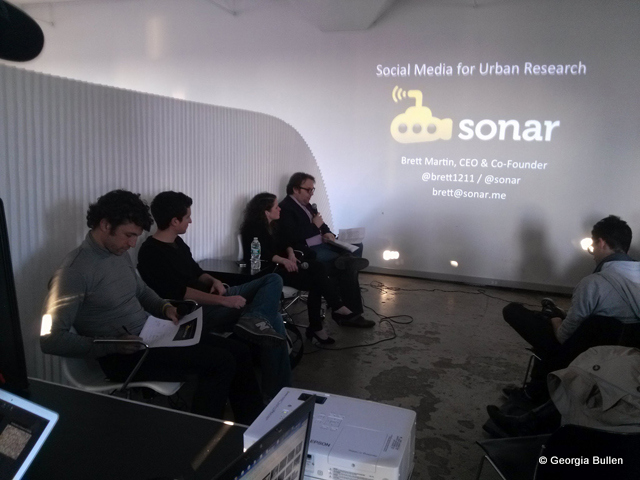The clean space of Studio X was a neat fit for Tuesday’s panel discussion on the potential of social media in the future of urban research and planning. New York Times journalist, Noam Cohen, moderated the discussion. He started by voicing popular concerns over governments’ usage of our data; the data generated by all the social media we now incorporate into our daily travails. Mr. Cohen remarked that social media has the positive effect of making us a “connected crowd in the city.” The seemingly random chaos of modern life has a “warp and woof to it,” he says, and these patterns can be used.
Brett Martin, of Sonar.me, continued on this theme. He presented where we are now with social media, along with current trends in research. Sonar.me is a mobile application that reveals the hidden connections around you. It is getting so easy to communicate, “we share you for you,” Marin says, all you have to do is download the app. There is an explosion of personal data now that can be leveraged, collected and shared. The trick is to utilize the best data for the best fit, “more data in, better data out.”
Martin relayed that the ad industry has also changed to incorporate social media in its campaigns, up by 40% in the last ten years. One strategy is the analsis of tweets for trends in sadness. For example, if there are a significant amount of negative messages from say, a specific McDonald’s restaurant, this will show as a pattern, and one that can be changed. He posited the thought that people define place. A place is what it is because of the people who go there. “So how do we design a place for us, not just an aggregate?” He considers a future where spaces can interact with and adapt to your identity, a personalization of place.
Fifteen million people have downloaded Foursquare, the mobile application that allows you to ‘check in,’ share your location, discover places, and get tips or deals. It pinpoints your position throughout the day. It is presented as a game with rewards but there are potentials for other uses being uncovered. Blake Shaw gave a presentation of Foursquare’s New York users and their mapped movements. His projections are like thermal images, with the city pulsing in different areas at different times of day; our patterns in behavior tracked and visualized, our daily rhythms dancing on the screen. Shaw says this is useful as it “can make cities easier to use ”¦ with recommendations curated by your peers.” He continued the theme of spaces being defined by people and their use of them, and also how places exist in time, or not, (after all, most of Central Park does not exist after midnight, at least not according to foursquare users) and this needs to be thought about when planning for the future.
“People connect places over time.” The point can be seen clearly with his time-lapse maps. They are like old sheep trails on the hills, well-worn paths from pasture to water. We take the easiest route. The data of these patterns of interaction can be leveraged to help design our cities in the future, he says.
It is time for the last speaker, but not before most of the crowd checks their messages.
Sarah Williams, at Columbia University’s Graduate School of Architecture, Planning and Preservation, presented last. She discussed the re-appropriation of the various media tools and applications and stated that they can be used in different ways for future research. Untapped previously covered her department’s work with the BitCity conference and fun visualizations of how Foursquare and Facebook measure voting with your feet in New York. They’ve also used Foursquare to successfully track the Garment District’s ongoing importance to New York’s fashion industry. The movements of designers and workers were mapped in and out of this “accessible agglomeration.” The Garment District is still needed and should be preserved, Ms. Williams argues, as the epicenter of a thriving industry. It is important precisely because of its situation in mid-town and because of its accessibility. This should be a major concern when rezoning is being considered.
Blake Shaw explained that you can only work on the data given, statistics are adjusted, but that there is “something powerful to be built” and that he sees these tools as “democratizing” communities and their businesses. Noam Cohen agrees that at the moment there will be a bias towards Americans of a certain age when collecting data from Foursquare (50% of users live in the U.S) but that these are ‘early adopters’ and are taken into consideration. Brett Martin made the point that the people behind Sonar.me, and other media, are businessmen and that it is in their interest to provide the best products for the public. It is also stated that whilst most of your personal data is only shared with those you want it to be shared with, there has to be some sort of trade off for the freedoms of cyberspace.
All exhibition content is online at https://weareherenow.org.
Follow Untapped Cities on Facebook and Twitter.






